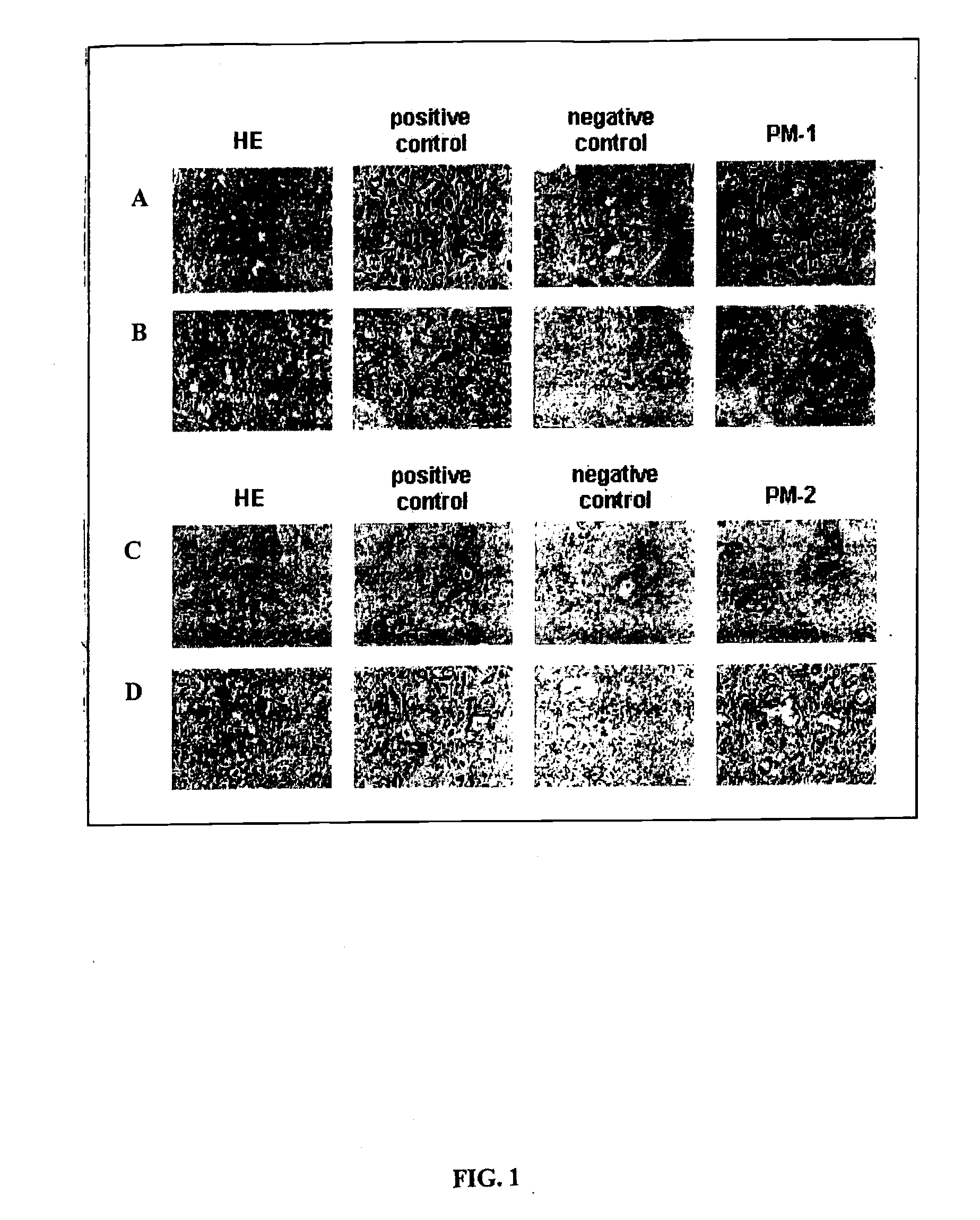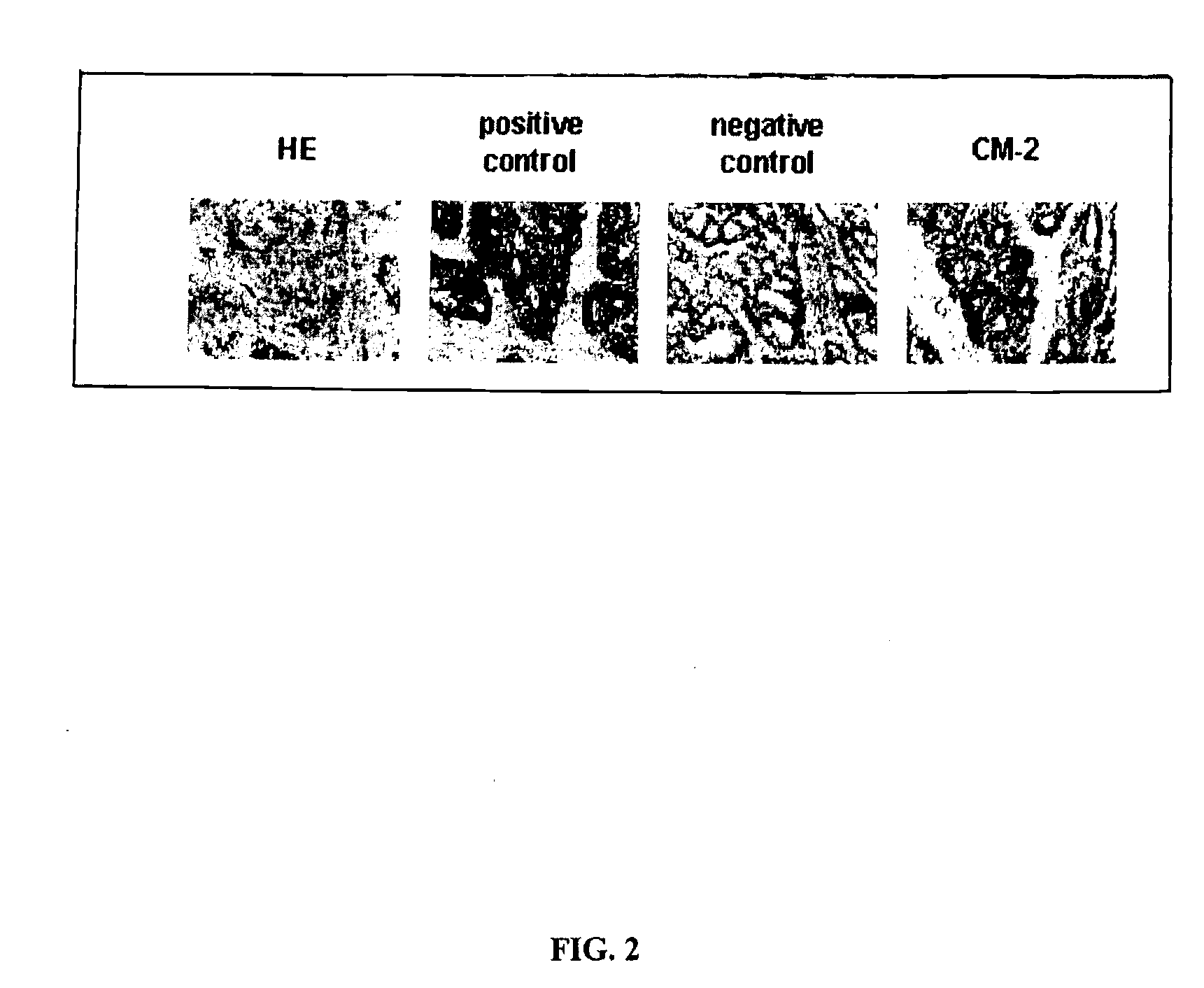Neoplasm specific antibodies and uses thereof
a technology of neoplasm and specific antibodies, applied in the field of cancer diagnosis and treatment, can solve the problem of poor prognosis in 50 years, and achieve the effect of excellent diagnostic tools
- Summary
- Abstract
- Description
- Claims
- Application Information
AI Technical Summary
Benefits of technology
Problems solved by technology
Method used
Image
Examples
example 1
Materials and Methods
Cell Culture
[0121] In this study the following human cell lines were used: BXPC-3 (pancreatic adenocarcinoma; ATCC (American Type Culture Collection, P.O. Box 1549, Manassas, Va. 20108) Accession No. CRL-1687), CACO-2 (colon adenocarcinoma), Colo-206F (colon carcinoma). The cell lines were cultured in RPM1-1640 media (PAA, Vienna, Austria) supplemented with 10% fetal calf serum (FCS), 2 mM glutamine and penicillin / streptomycin (both 1%) and incubated in a humidified, 5% CO2 atmosphere at 37° C. For the assays described, cells were grown to sub-confluency, detached with trypsin / EDTA and washed twice with phosphate-buffered saline (PBS) before use.
Producing Hybridomas
[0122] We immortalized lymphocytes by fusing them to the HAB-1 heteromyeloma as follows.
[0123] We washed the HAB-1 heteromyeloma cells twice with RPMI 1640 (PAA, Vienna, Austria) without additives and centrifuged the cells for 5 minutes at 1500 rpm. We then thawed frozen lymphocytes obtained fr...
example 2
Generation of the Cell Line Expressing the PM-1, PM-2, or CM-2 Monoclonal Antibody
[0143] As described above, we obtained the PM-1, PM-2, or CM-2 monoclonal antibody expressing hybridoma by fusing lymphocytes obtained from the spleen or lymph nodes of a cancer patient with the heteromyeloma cell line HAB-1 (Faller, et al., Br. J. Cancer 62:595-598, 1990). The lymphoid sources were not pre-selected in terms of the age or sex of the patient. The resultant cell is a type of hybridoma known as a trioma, as it is the fusion of three cells. Like normal B-lymphocytes, this trioma has to ability to produce antibodies. The specificity of the antibody is determined by the specificity of the original lymphocyte from the patient that was used to generate the trioma.
[0144] The hybridoma supernatants were screened for antibody production using an ELISA assay. Following ELISA, antibodies were primarily tested immunohistochemically against their autologous tumor for tumor specific reactivity. Anti...
example 3
Immunohistochemical Characterization of an Antibody
[0151] To characterize the monoclonal antibody secreted by a hybridoma, we tested the antibody against a panel of normal and tumor tissues using an immunoperoxidase assay as described in the materials and methods. This assay provided us with an overview of which tissues were stained by the antibody and of the distribution of the antigen.
[0152] Antibodies that are specific for tumor cells and not for normal tissue were further characterized. First, we tested these antibodies against the same types of tumors from different patients. We then tested these antibodies against tumors of other organs and, finally, against normal tissues. Using these assays, we identified the human PM-1, PM-2, and CM-2 monoclonal antibodies. The tumor reactive antibodies generated and described in this study are of the IgM / λ isotype (see Table 1).
TABLE 1Origin of Monoclonal IgM Antibodies and ClinicalData of Cancer PatientsTumourTumourSource ofIgAntibody...
PUM
| Property | Measurement | Unit |
|---|---|---|
| temperature | aaaaa | aaaaa |
| temperature | aaaaa | aaaaa |
| molecular weights | aaaaa | aaaaa |
Abstract
Description
Claims
Application Information
 Login to View More
Login to View More - R&D
- Intellectual Property
- Life Sciences
- Materials
- Tech Scout
- Unparalleled Data Quality
- Higher Quality Content
- 60% Fewer Hallucinations
Browse by: Latest US Patents, China's latest patents, Technical Efficacy Thesaurus, Application Domain, Technology Topic, Popular Technical Reports.
© 2025 PatSnap. All rights reserved.Legal|Privacy policy|Modern Slavery Act Transparency Statement|Sitemap|About US| Contact US: help@patsnap.com



